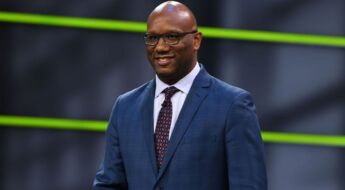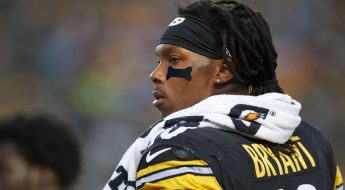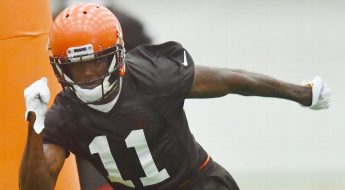Rick Mirer spent one season in a Bears uniform and had very little to show for it. Jim Davis/The Boston Globe via Getty Images Over the years, if the draft proved to be a minefield for the Bears to select quarterbacks, they helped their cause very little with large-scale trades on which they pinned QB savior hopes.
In 1997, the Bears traded a first-round pick to Seattle for quarterback Rick Mirer. Coming off a 1996 season in which the Bears used three quarterbacks — Kramer, Krieg and Shane Matthews — the Bears and head coach Dave Wannstedt looked desperate for a solution and stability at quarterback. In Seattle, they saw perhaps what they missed in the 1979 draft in Mirer.
Indeed, not only did Mirer physically resemble Montana, but his storied career at Notre Dame included a 1992 Sugar Bowl win, a 1993 Cotton Bowl win and the most offensive productivity of any player in Notre Dame history — 41 career touchdown passes, 5,997 passing yards and 17 rushing touchdowns. The Seahawks selected Mirer with the No. 2 pick overall in the 1993 draft.
He won offensive rookie of the year in 1993, setting the Seahawks’ rookie passing records, but after two somewhat inconsistent seasons, the Seahawks and new head coach Dennis Erickson had seen enough. But the Bears’ brass thought Mirer could be reinvigorated in Chicago and was worth trading the draft pick.
However, the dynamic running/passing combination everyone saw at Notre Dame was replaced by a player with nervous feet, low confidence and a penchant for throwing on the run. Some blamed bad habits Mirer picked up in Seattle, others blamed the Bears for plopping Mirer into a jumble of quarterback soup in which none of the players felt secure or comfortable. Mirer lasted only one season in Chicago, posting a miserable 37.7 passer rating in just three starts.
In April 2009, then-general manager Jerry Angelo swung for the fences and acquired cannon-armed Jay Cutler from Denver in exchange for a pair of first-round picks, a third-round pick and Kyle Orton (the Bears also got back a fifth-round choice).
The Bears’ futility at the quarterback position during the Super Bowl era — including Jay Cutler — has bewildered team personnel and media alike. Streeter Lecka/Getty Images
Over eight seasons, Cutler became the most statistically decorated quarterback in franchise history. At 102 games, Cutler by far started the most games of any Bears quarterback in the Super Bowl era. He passed for more than 23,000 yards, 154 touchdowns and an 85.2 passer rating. For perspective, in nearly every category Cutler’s numbers more than double McMahon’s, who sits third in games started for the Bears. Cutler’s pass attempts also are more than double McMahon’s and he correspondingly threw double the interceptions.
But McMahon’s legacy was cemented by the Bears’ 1985 Super Bowl win. Cutler’s legacy, on the other hand, is, well, complicated.
“I said at the time that I was not for the trade,” Turner said. “I said at the time that Orton was getting better and the guys in the locker room loved him. Kyle was a leader. The team respected him. There is no doubt we would have won a lot of games and Orton would have had a very, very good career had we just left him as the starter. I was not for the trade at all. But the trade was made, you deal with it, and you move on. I can understand why Jerry [Angelo] made the trade, but I didn’t think it was best for the team, and a lot of guys in the locker room didn’t think so, either.”
Turner worked with Cutler for only one season.
“It was just an up-and-down year,” Turner said. “Jay was up and down. I don’t think he ever bought into what we were doing. He wanted his own coordinator in there. He wanted someone different. His demeanor and his attitude and his preparation kind of showed that. Everyone talks about Jay’s demeanor and body language and stuff like that, but it was just a situation where he didn’t totally buy in and it just didn’t work.”
Cutler’s attitude and body language became stuff of legend.
“Just my opinion of Jay, he seemed kind of aloof,” Miller said. “I don’t know if he ever embraced the city like I did or other quarterbacks did. I think you have to have a connection, and I don’t think he ever had that connection where he was all-in.”
INJURIES: McMAHON, KRAMER DERAILED
Neck injuries derailed Erik Kramer’s career after a great 1995 campaign during which he set Bears single-season passing records. Focus on Sport/Getty Images
Injuries also adversely affected the careers of Bears quarterbacks, which subsequently derailed the Bears’ postseason hopes in routine fashion. McMahon led the Bears to their only Super Bowl championship in 1985 but struggled to stay healthy in subsequent years.
Kramer enjoyed one of the most prolific seasons by a Bears quarterback in 1995, when he passed for 3,838 yards, 29 touchdowns and 10 interceptions. The next year, he threw just three touchdowns and six interceptions while plagued by injury.
“I think he made a mistake in the offseason after the 1995 year,” Turner said. “The year before that, after the 1994 season, he stayed in Chicago and worked out a lot at Halas Hall and was in the office watching film when he could be. Then he has the successful year in ’95, and the next offseason they went back to California where he told me he planned to train when he wasn’t back in Chicago for OTAs and stuff like that.
“I don’t think that helped him. I told him, ‘Erik, I think you are making a major mistake. You had all that success last season when you spent the offseason here and working out with our guys here.’ But he made that decision, and sure enough he got hurt. Now, I don’t know if he got hurt because he made the decision to train in California, but he suffered a hamstring injury in the preseason and just never got back in sync that year.”
Miller had a terrific year in 2001, when he guided the Bears to a surprise 13-3 record and a division title, but Miller suffered a nasty shoulder injury in Chicago’s home playoff loss to the Eagles.
“That shoulder injury was more severe than anybody thought,” Miller said. “I came back the following year and my shoulder wasn’t right. I ended up playing the whole year with it. I did a lot more damage than anybody thought. It took me six surgeries to get my shoulder right. It was just unfortunate. I felt I had found my place. I felt very comfortable in Chicago. I was ready. I felt I was ready. I felt this was the perfect city for me — blue collar like me, they think like me and they appreciate hard work and effort.”
The Bears released Miller before the 2003 season.
Arguably Cutler’s best stretch came in 2011, prior to suffering a season-ending thumb injury in the Bears’ 10th game versus the Chargers. The Bears, 7-3 at the time of Cutler’s injury, went on to lose five consecutive games and miss the playoffs.
“I remember telling my family at the time that Jay was carrying the team,” former Bears quarterback Caleb Hanie (2008-11) said. “The offense was not operating the way [offensive coordinator Mike] Martz wanted it to operate, but Jay is just making a lot of stuff happen because he’s moving around and making crazy plays with his arm and his feet. Everyone likes to hate on Jay, but you saw what happened when he was gone.”
BAD COACHING CREATES ‘TOXIC ENVIRONMENT’
“Da Coach” Mike Ditka was tough on young quarterbacks like Jim Harbaugh. AP Photo/Fred Jewell
According to Pierson, Mike Ditka might have been many things but a great quarterbacks coach he was not. Bears fans might remember vividly Ditka routinely berating Harbaugh on the sidelines as well as in postgame dress-downs.
“McMahon knew more offense than anybody in the building. Coaching was a problem in that era, too,” Pierson said.
Cutler, too, learned quickly that the grass isn’t always greener when it comes to coaches. The continuity needed for success was lacking, as the Bears changed playcallers (Martz, Mike Tice, Marc Trestman, Adam Gase, Dowell Loggains) five more times before Cutler’s time in Chicago concluded.
“They fired Turner and [quarterbacks coach] Pep Hamilton after 2009,” Hanie said. “I liked both of those guys, but the thought at the time was that Jay needed more creativity. The first hire the Bears made was Tice as offensive line coach. Then they hired Martz as the OC. After working with those guys for two years, I came to learn that Tice and Martz were polar opposites in how they viewed offense.
“Huge, huge conflict. When the s— hits the fan during the season, then people start playing the blame game. That was a big problem in that era. There was some finger-pointing going on behind the scenes. I remember hearing the dirty laundry. The coaches didn’t keep it to themselves. That was a very toxic environment.”
BAD LUCK: EVEN A ROSARY COULDN’T SAVE BEARS’ QB
After McMahon, even divine intervention didn’t bestow another franchise quarterback on Mike Ditka. Rob Kozloff/AP Photo
Not even divine intervention could save Chicago’s quarterbacks.
“In 1984, they had seven or eight quarterbacks they had to play,” Pierson said. “One game they had to play a quarterback named Rusty Lisch. Now, Rusty is a very religious guy. So, Rusty screws up and Ditka pulls him out of the game and just cusses him up and down. Later on in the same game, another Bears quarterback gets hurt and Ditka has to put Lisch back in the game.
“Well … Lisch won’t go back in. Ditka is furious, ‘What do you mean he won’t go back in?’ The assistant coach tells him, ‘Mike, you can’t talk to Rusty like that.’ On the plane ride home Lisch is reading the Bible and Ditka walks up to him and goes, ‘I hope there is something in that book about job opportunities, because you’ll need one on Monday.’ Lisch responded by bringing Ditka a rosary on Monday to try and calm him down.”
It didn’t work, either.





